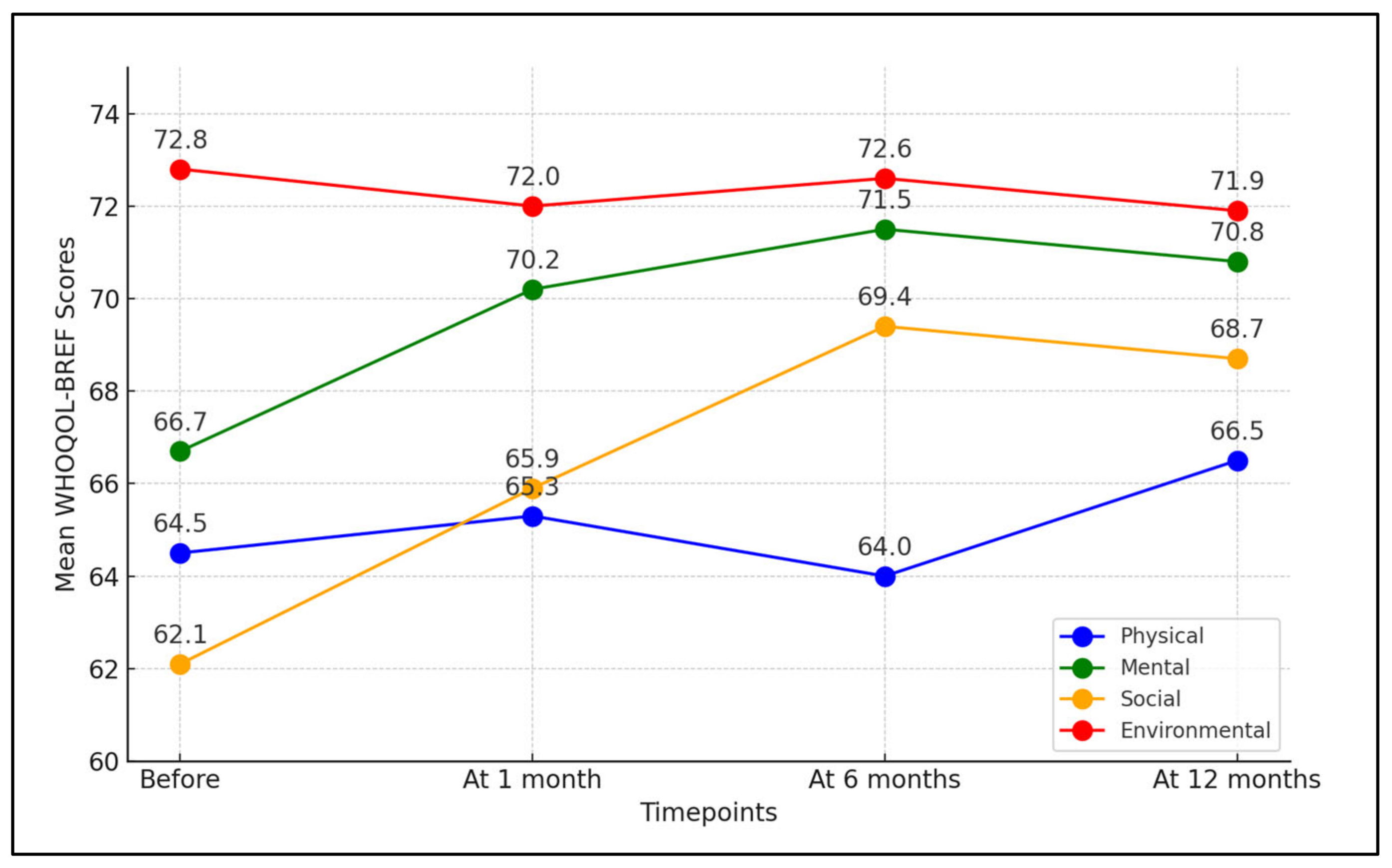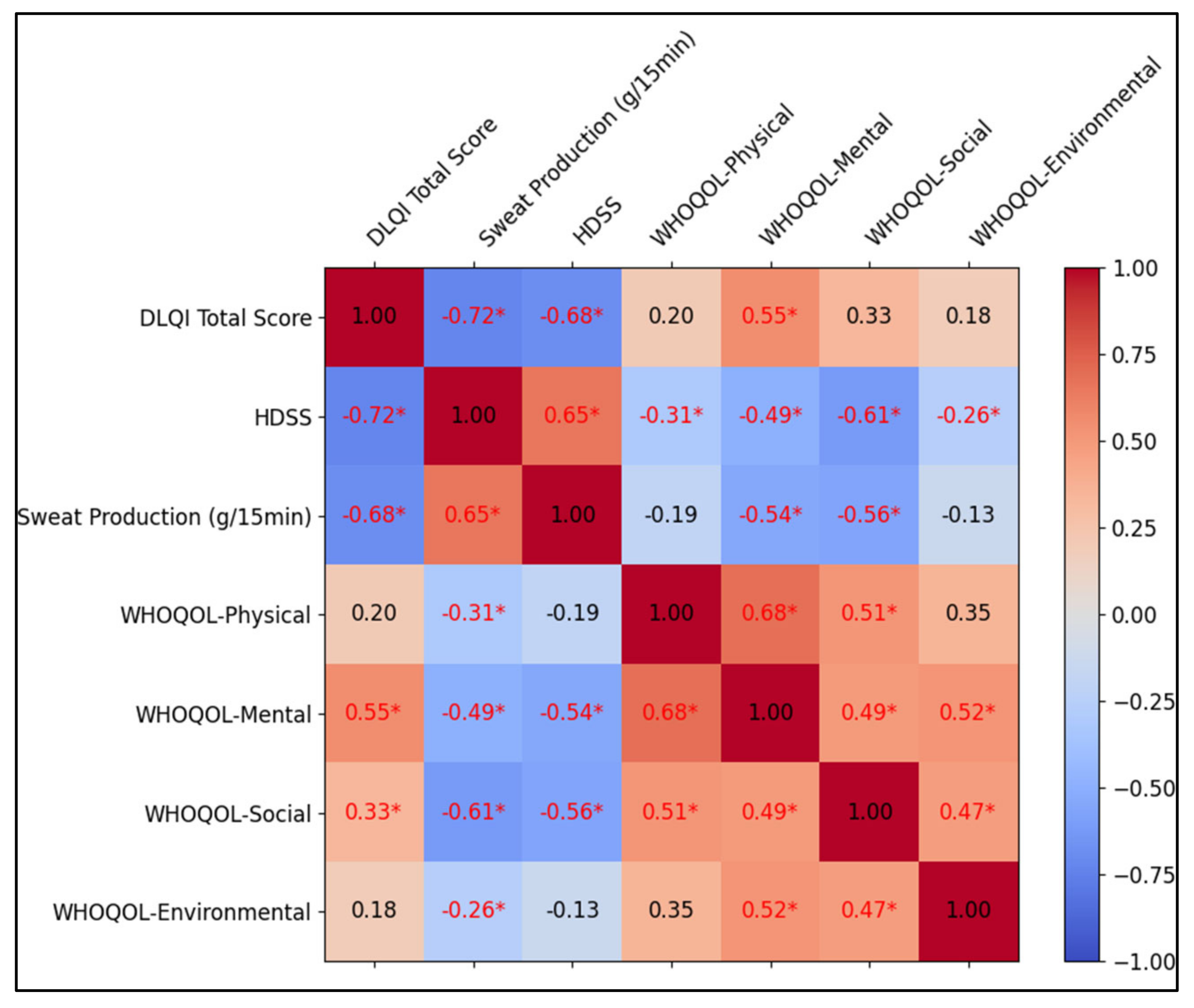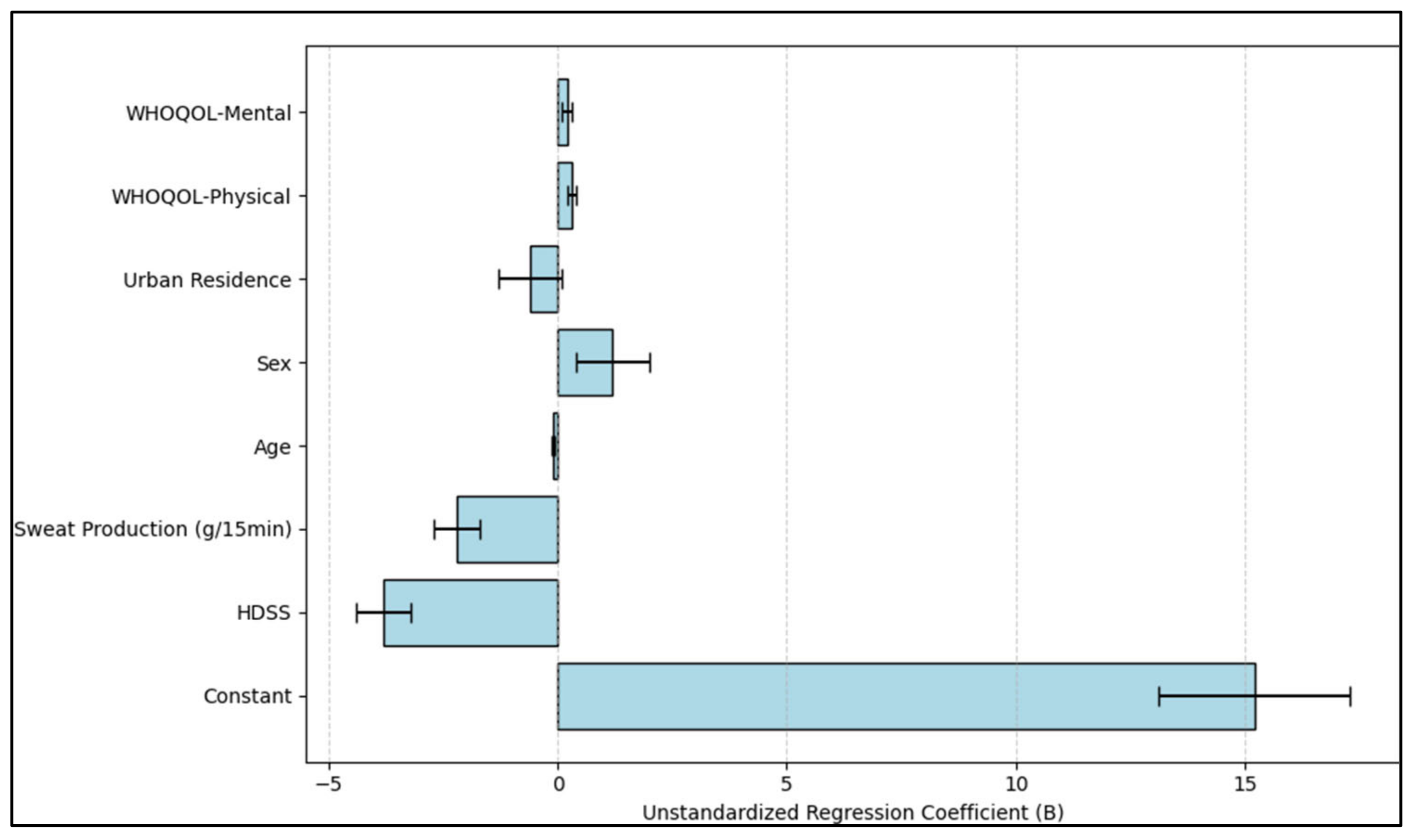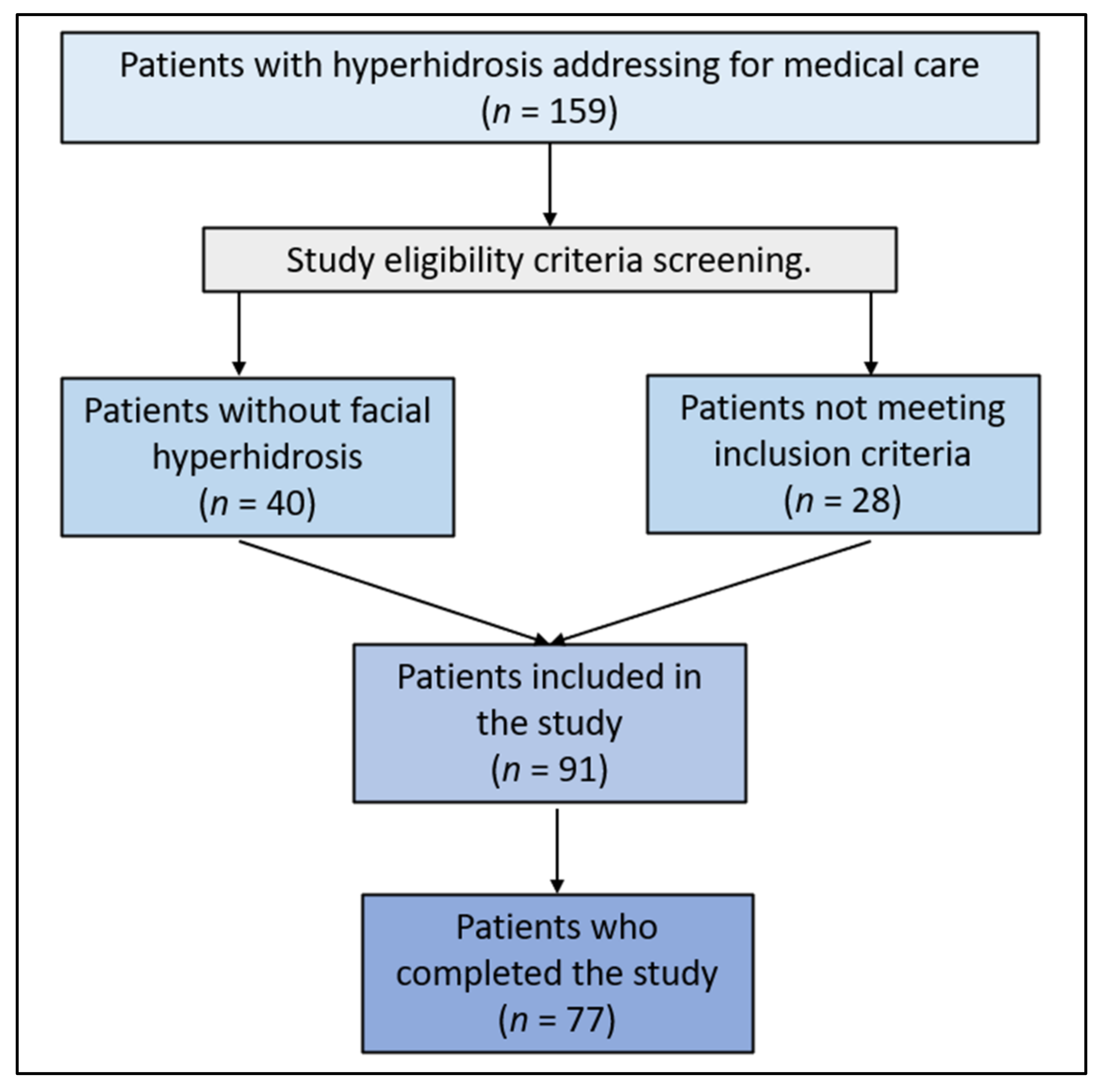Longitudinal Assessment of Facial Hyperhidrosis Management: Evaluating the Utility and Quality of Life Improvements following Botulinum Toxin Injection
Abstract
1. Introduction
2. Results
3. Discussion
4. Conclusions
5. Materials and Methods
5.1. Research Design and Ethical Considerations
5.2. Inclusion and Exclusion Criteria
5.3. Variables and Procedures
5.4. Surveys Employed
- Facial Sweating Severity: How severe is your facial sweating on a scale of 1 to 10, where 1 is no sweating, and 10 is extremely severe sweating?
- Sweating Management: How well can you manage your facial hyperhidrosis-associated sweating? (1—not effectively at all, 10—extremely effectively)
- Impact on Daily Activities: How much does facial hyperhidrosis interfere with your everyday activities? (1—no impact, 10—a significant impact)
- Mood and Emotional Well-being: How do you rate your mood and emotional well-being overall? (1—very poor, 10—excellent)
- Social Engagement: How comfortable are you in social situations while experiencing facial sweating? (1—very uncomfortable, 10—very comfortable)
- Personal Relationships: How has facial sweating impacted your relationships with family, friends, etc.? (1—not affected at all, 10—significantly affected)
- Professional and Educational Activities: How has facial hyperhidrosis affected your professional or educational pursuits? (1—no impact, 10—a significant impact)
- Self-Confidence: What is your level of self-confidence in social and professional environments? (1—very low, 10—very high)
- Sleep Quality: How has facial hyperhidrosis influenced the quality of your sleep? (1—very poor, 10—excellent)
- Overall Quality of Life: How would you rate your overall life quality with facial hyperhidrosis? (1—very poor, 10—excellent).
5.5. Software and Statistical Analysis
Author Contributions
Funding
Institutional Review Board Statement
Informed Consent Statement
Data Availability Statement
Conflicts of Interest
References
- Kisielnicka, A.; Szczerkowska-Dobosz, A.; Purzycka-Bohdan, D.; Nowicki, R. Hyperhidrosis: Disease aetiology, classification and management in the light of modern treatment modalities. Postepy Dermatol. Allergol. 2022, 39, 251–257. [Google Scholar] [CrossRef]
- Brackenrich, J.; Fagg, C. Hyperhidrosis. [Updated 3 October 2022]. In StatPearls; StatPearls Publishing: Treasure Island, FL, USA, 2023. Available online: https://www.ncbi.nlm.nih.gov/books/NBK459227/ (accessed on 7 December 2023).
- Kamudoni, P.; Mueller, B.; Halford, J.; Schouveller, A.; Stacey, B.; Salek, M. The impact of hyperhidrosis on patients’ daily life and quality of life: A qualitative investigation. Health Qual. Life Outcomes 2017, 15, 121. [Google Scholar] [CrossRef]
- Lakraj, A.-A.D.; Moghimi, N.; Jabbari, B. Hyperhidrosis: Anatomy, Pathophysiology and Treatment with Emphasis on the Role of Botulinum Toxins. Toxins 2013, 5, 821–840. [Google Scholar] [CrossRef]
- Ribeiro Santos Morard, M.; Betanho Martins, R.; Lopes Ribeiro, A.C.; Guimarães Rocha Lima, P.; Dos Santos Carvalho, B.; Junior, J.C.B.S. Primary hyperhidrosis prevalence and characteristics among medical students in Rio de Janeiro. PLoS ONE 2019, 14, e0220664. [Google Scholar] [CrossRef] [PubMed]
- Stashak, A.-B.; Brewer, J.D. Management of hyperhidrosis. Clin. Cosmet. Investig. Dermatol. 2014, 7, 285–299. [Google Scholar] [CrossRef] [PubMed][Green Version]
- Kim, D.H.; Kim, T.H.; Lee, S.H.; Lee, A.Y. Treatment of Palmar Hyperhidrosis with Tap Water Iontophoresis: A Randomized, Sham-Controlled, Single-Blind, and Parallel-Designed Clinical Trial. Ann. Dermatol. 2017, 29, 728–734. [Google Scholar] [CrossRef]
- Stefaniak, T.J.; Ćwigoń, M. Long-term results of thoracic sympathectomy for primary hyperhidrosis. Pol. Przegl. Chir. 2013, 85, 247–252. [Google Scholar] [CrossRef] [PubMed]
- Vannucci, F.; Araújo, J.A. Thoracic sympathectomy for hyperhidrosis: From surgical indications to clinical results. J. Thorac. Dis. 2017, 9 (Suppl. S3), S178–S192. [Google Scholar] [CrossRef]
- Lowe, N.; Naumann, M.; Eadie, N.M. Treatment of hyperhidrosis with Botox (onabotulinumtoxinA): Development, insights, and impact. Medicine 2023, 102 (Suppl. S1), e32764. [Google Scholar] [CrossRef]
- Choudhury, S.; Baker, M.R.; Chatterjee, S.; Kumar, H. Botulinum Toxin: An Update on Pharmacology and Newer Products in Development. Toxins 2021, 13, 58. [Google Scholar] [CrossRef]
- Campanati, A.; Diotallevi, F.; Radi, G.; Martina, E.; Marconi, B.; Bobyr, I.; Offidani, A. Efficacy and Safety of Botulinum Toxin B in Focal Hyperhidrosis: A Narrative Review. Toxins 2023, 15, 147. [Google Scholar] [CrossRef] [PubMed]
- Shibasaki, M.; Davis, S.; Cui, J.; Low, D.; Keller, D.; Crandall, C. Botulinum toxin abolishes sweating via impaired sweat gland responsiveness to exogenous acetylcholine. Br. J. Dermatol. 2009, 161, 757–761. [Google Scholar] [CrossRef] [PubMed]
- Stuart, M.E.; Strite, S.A.; Gillard, K.K. A systematic evidence-based review of treatments for primary hyperhidrosis. J. Drug Assess. 2020, 10, 35–50. [Google Scholar] [CrossRef] [PubMed]
- Post, M. Definitions of Quality of Life: What Has Happened and How to Move On. Top. Spinal Cord Inj. Rehabil. 2014, 20, 167–180. [Google Scholar] [CrossRef] [PubMed]
- Shayesteh, A.; Persson, M.; Brulin, C.; Nylander, E. ‘Excessive sweating is not a feminine thing’: A qualitative study of women’s experiences suffering from primary hyperhidrosis. PLoS ONE 2021, 16, e0254689. [Google Scholar] [CrossRef] [PubMed]
- Naumann, M.; Lowe, N.J. Botulinum toxin type A in treatment of bilateral primary axillary hyperhidrosis: Randomised, parallel group, double blind, placebo controlled trial. BMJ 2001, 323, 596. [Google Scholar] [CrossRef] [PubMed]
- Doft, M.A.; Hardy, K.L.; Ascherman, J.A. Treatment of Hyperhidrosis with Botulinum Toxin. Aesthetic Surg. J. 2012, 32, 238–244. [Google Scholar] [CrossRef] [PubMed]
- Karlqvist, M.; Rosell, K.; Rystedt, A.; Hymnelius, K.; Swartling, C. Botulinum toxin B in the treatment of craniofacial hyperhidrosis. J. Eur. Acad. Dermatol. Venereol. 2013, 28, 1313–1317. [Google Scholar] [CrossRef]
- Bragança, G.M.G.; Lima, S.O.; Neto, A.F.P.; Marques, L.M.; de Melo, E.V.; Reis, F.P. Evaluation of anxiety and depression prevalence in patients with primary severe hyperhidrosis. An. Bras. Dermatol. 2014, 89, 230–235. [Google Scholar] [CrossRef]
- Ando’, A.; Di Girolamo, M.; Pignolo, C.; Zennaro, A.; Giromini, L.; Minichino, A.; Salatino, A.; Morese, R. Personality features and vulnerability to stress: A case study on hyperhidrosis. Res. Psychother. 2019, 22, 344. [Google Scholar] [CrossRef]
- Wolosker, N.; Faustino, C.B.; da Silva, M.F.A.; de Campos, J.R.M.; Kauffman, P. Current treatment options for craniofacial hyperhidrosis. J. Vasc. Bras. 2020, 19, e20190152. [Google Scholar] [CrossRef] [PubMed]
- Obed, D.; Salim, M.; Bingoel, A.S.; Hofmann, T.R.; Vogt, P.M.; Krezdorn, N. Botulinum Toxin Versus Placebo: A Meta-Analysis of Treatment and Quality-of-life Outcomes for Hyperhidrosis. Aesthetic Plast. Surg. 2021, 45, 1783–1791. [Google Scholar] [CrossRef] [PubMed]
- Campanati, A.; Martina, E.; Gregoriou, S.; Kontochristopoulos, G.; Paolinelli, M.; Diotallevi, F.; Radi, G.; Bobyr, I.; Marconi, B.; Gualdi, G.; et al. Botulinum Toxin Type A for Treatment of Forehead Hyperhidrosis: Multicenter Clinical Experience and Review from Literature. Toxins 2022, 14, 372. [Google Scholar] [CrossRef] [PubMed]
- Glaser, D.A.; Galperin, T.A. Botulinum toxin for hyperhidrosis of areas other than the axillae and palms/soles. Dermatol. Clin. 2014, 32, 517–525. [Google Scholar] [CrossRef] [PubMed]
- Park, E.J.; Han, K.R.; Choi, H.; Kim, D.W.; Kim, C. An epidemiological study of hyperhidrosis patients visiting the Ajou university hospital hyperhidrosis center in Korea. J. Korean Med. Sci. 2010, 25, 772–775. [Google Scholar] [CrossRef]
- Hamm, H.; Naumann, M.K.; Kowalski, J.W.; Kütt, S.; Kozma, C.; Teale, C. Primary focal hyperhidrosis: Disease characteristics and functional impairment. Dermatology 2006, 212, 343–353. [Google Scholar] [CrossRef]
- Strutton, D.R.; Kowalski, J.W.; Glaser, D.A.; Stang, P.E. US prevalence of hyperhidrosis and impact on individuals with axillary hyperhidrosis: Results from a national survey. J. Am. Acad. Dermatol. 2004, 51, 241–248. [Google Scholar] [CrossRef]
- Kamudoni, P.; Mueller, B.; Salek, M.S. The development and validation of a disease-specific quality of life measure in hyperhidrosis: The hyperhidrosis quality of life index (HidroQOL©). Qual. Life Res. 2015, 24, 1017–1027. [Google Scholar] [CrossRef]
- Mirkovic, S.; Rystedt, A.; Balling, M.; Swartling, C. Hyperhidrosis substantially reduces quality of life in children: A retrospective study describing symptoms, consequences and treatment with botulinum toxin. Acta Derm.-Venereol. 2018, 98, 103–107. [Google Scholar] [CrossRef]
- Bohaty, B.R.; Hebert, A.A. Special considerations for children with hyperhidrosis. Dermatol. Clin. 2014, 32, 477–484. [Google Scholar] [CrossRef]
- Wolosker, N.; Schvartsman, C.; Krutman, M.; Campbell, T.P.D.A.; Kauffman, P.; de Campos, J.R.M.; Puech-Leão, P. Efficacy and quality of life outcomes of oxybutynin for treating palmar hyperhidrosis in children younger than 14 years old. Pediatr. Dermatol. 2014, 31, 48–53. [Google Scholar] [CrossRef] [PubMed]
- Kouris, A.; Armyra, K.; Stefanaki, C.; Christodoulou, C.; Karimali, P.; Kontochristopoulos, G. Quality of life and social isolation in greek adolescents with primary focal hyperhidrosis treated with botulinum toxin type A: A case series. Pediatr. Dermatol. 2015, 32, 226–230. [Google Scholar] [CrossRef] [PubMed]
- Shayesteh, A.; Janlert, U.; Nylander, E. Hyperhidrosis—Sweating sites matter: Quality of life in primary hyperhidrosis according to the sweating sites measured by SF-36. Dermatology 2017, 233, 441–445. [Google Scholar] [CrossRef]
- Varella, A.Y.M.; Fukuda, J.M.; Teivelis, M.P.; De Campos, J.R.M.; Kauffman, P.; Cucato, G.G.; Puech-Leão, P.; Wolosker, N. Translation and validation of Hyperhidrosis Disease Severity Scale. Rev. Assoc. Med. Bras. 2016, 62, 843–847. [Google Scholar] [CrossRef] [PubMed]
- Băjenaru, L.; Balog, A.; Dobre, C.; Drăghici, R.; Prada, G.-I. Latent profile analysis for quality of life in older patients. BMC Geriatr. 2022, 22, 848. [Google Scholar] [CrossRef]
- Nicolescu, A.C.; Ionescu, M.-A.; Constantin, M.M.; Ancuta, I.; Ionescu, S.; Niculet, E.; Tatu, A.L.; Zirpel, H.; Thaçi, D. Psoriasis Management Challenges Regarding Difficult-to-Treat Areas: Therapeutic Decision and Effectiveness. Life 2022, 12, 2050. [Google Scholar] [CrossRef]
- Ilić, I.; Šipetić-Grujičić, S.; Grujičić, J.; Mačužić, I.; Kocić, S.; Ilić, M. Psychometric Properties of the World Health Organization’s Quality of Life (WHOQOL-BREF) Questionnaire in Medical Students. Medicina 2019, 55, 772. [Google Scholar] [CrossRef]
- Barbieri, J.S.; Gelfand, J.M. Evaluation of the Dermatology Life Quality Index scoring modification, the DLQI-R score, in two independent populations. Br. J. Dermatol. 2019, 180, 939–940. [Google Scholar] [CrossRef]




| Variables | n = 77 | % |
|---|---|---|
| Age (mean ± SD) | 32.5 ± 9.8 | - |
| Sex | ||
| Male | 35 | 45.5% |
| Female | 42 | 54.5% |
| Area of residence | ||
| Urban | 47 | 61.0% |
| Rural | 30 | 39.0% |
| Partnership status | ||
| Divorced or Single | 25 | 32.5% |
| In a relationship or Married | 52 | 67.5% |
| Employment/educational status | ||
| Working | 50 | 64.9% |
| Studying | 15 | 19.5% |
| None of the above | 12 | 15.6% |
| Length of symptoms, months (mean ± SD) | 18.2 ± 12.4 | - |
| Severity of hyperhidrosis | ||
| HDSS < 3 | 40 | 51.9% |
| HDSS ≥ 3 | 37 | 48.1% |
| Questions (1–10) | Before | At 1 Month | At 6 Months | At 12 Months | p-Value * |
|---|---|---|---|---|---|
| Facial Sweating Severity | 7.5 ± 1.2 | 4.2 ± 0.9 | 5.0 ± 2.2 | 4.5 ± 1.1 | <0.001 |
| Sweating Management | 5.1 ± 2.3 | 6.8 ± 1.4 | 7.5 ± 1.2 | 7.0 ± 3.5 | <0.001 |
| Impact on Daily Activities | 6.4 ± 1.6 | 4.9 ± 2.1 | 5.1 ± 1.3 | 5.8 ± 1.9 | <0.001 |
| Mood and Emotional Well-being | 6.5 ± 3.4 | 6.2 ± 2.3 | 6.7 ± 3.2 | 6.4 ± 3.1 | 0.779 |
| Social Engagement | 5.8 ± 2.5 | 6.3 ± 2.0 | 7.0 ± 3.1 | 7.1 ± 3.3 | 0.011 |
| Personal Relationships | 6.2 ± 1.6 | 6.8 ± 1.2 | 6.9 ± 2.4 | 6.5 ± 2.8 | 0.157 |
| Professional and Educational Activities | 5.5 ± 2.1 | 6.3 ± 2.8 | 6.6 ± 3.7 | 5.9 ± 3.5 | 0.138 |
| Self-Confidence | 5.9 ± 1.2 | 7.7 ± 1.3 | 7.9 ± 1.0 | 7.6 ± 1.2 | <0.001 |
| Sleep Quality | 7.0 ± 1.8 | 7.1 ± 2.4 | 7.3 ± 2.1 | 6.8 ± 1.5 | 0.466 |
| Overall Quality of Life | 6.7 ± 3.5 | 7.4 ± 2.2 | 7.5 ± 1.3 | 7.2 ± 2.4 | 0.192 |
| WHOQOL-BREF (Mean ± SD) | Before | At 1 Month | At 6 Months | At 12 Months | p-Value * |
|---|---|---|---|---|---|
| Physical domain | 64.5 ± 5.2 | 65.3 ± 4.6 | 64.0 ± 4.8 | 66.5 ± 5.1 | 0.011 |
| Mental domain | 66.7 ± 6.1 | 70.2 ± 5.0 | 71.5 ± 6.7 | 70.8 ± 5.2 | <0.001 |
| Social domain | 62.1 ± 5.7 | 65.9 ± 4.4 | 69.4 ± 4.9 | 68.7 ± 5.3 | <0.001 |
| Environmental domain | 72.8 ± 6.3 | 72.0 ± 5.5 | 72.6 ± 5.2 | 71.9 ± 5.6 | 0.703 |
| Variables (Mean ± SD) | Before | At 1 Month | At 6 Months | At 12 Months | p-Value |
|---|---|---|---|---|---|
| DLQI total score | 24.8 ± 4.2 | 6.2 ± 2.1 | 5.9 ± 2.3 | 6.5 ± 2.5 | <0.001 |
| HDSS | 3.6 ± 0.5 | 1.2 ± 0.8 | 1.1 ± 0.7 | 1.3 ± 0.6 | <0.001 |
| Sweat production (g/15 min) | 0.75 ± 0.15 | 0.18 ± 0.07 | 0.16 ± 0.05 | 0.20 ± 0.08 | <0.001 |
| Variables (rho, p-Value) | DLQI Total Score | HDSS | Sweat Production (g/15 min) | WHOQOL-Physical | WHOQOL-Mental | WHOQOL-Social | WHOQOL-Environmental |
|---|---|---|---|---|---|---|---|
| DLQI Total Score | 1 | ||||||
| HDSS | −0.72, <0.001 | 1 | |||||
| Sweat Production (g/15 min) | −0.68, <0.001 | 0.65, <0.001 | 1 | ||||
| WHOQOL-Physical | 0.20, 0.194 | −0.31, 0.016 | −0.19, 0.430 | 1 | |||
| WHOQOL-Mental | 0.55, <0.001 | −0.49, 0.002 | −0.54, 0.002 | 0.68, <0.001 | 1 | ||
| WHOQOL-Social | 0.33, 0.062 | −0.61, <0.001 | −0.56, <0.001 | 0.51, 0.001 | 0.49, <0.001 | 1 | |
| WHOQOL-Environmental | 0.18, 0.355 | −0.26, 0.193 | −0.13, 0.386 | 0.35, 0.092 | 0.52, <0.001 | 0.47, <0.001 | 1 |
| Variables | B Coefficient | Standard Error | Beta | t-Value | p-Value |
|---|---|---|---|---|---|
| Constant | 15.2 | 2.1 | - | 7.24 | <0.001 |
| HDSS | −3.8 | 0.6 | −0.45 | −6.33 | <0.001 |
| Sweat Production (g/15 min) | −2.2 | 0.5 | −0.3 | −4.4 | <0.001 |
| Age | −0.1 | 0.03 | −0.18 | −3.33 | 0.001 |
| Sex (1 = Male, 0 = Female) | 1.2 | 0.8 | 0.09 | 1.5 | 0.136 |
| Urban Residence (1 = Urban, 0 = Rural) | −0.6 | 0.7 | −0.05 | −0.85 | 0.396 |
| WHOQOL-Physical | 0.3 | 0.1 | 0.15 | 3.0 | 0.003 |
| WHOQOL-Mental | 0.2 | 0.1 | 0.12 | 2.0 | 0.046 |
Disclaimer/Publisher’s Note: The statements, opinions and data contained in all publications are solely those of the individual author(s) and contributor(s) and not of MDPI and/or the editor(s). MDPI and/or the editor(s) disclaim responsibility for any injury to people or property resulting from any ideas, methods, instructions or products referred to in the content. |
© 2024 by the authors. Licensee MDPI, Basel, Switzerland. This article is an open access article distributed under the terms and conditions of the Creative Commons Attribution (CC BY) license (https://creativecommons.org/licenses/by/4.0/).
Share and Cite
Prodan-Barbulescu, C.; Castiglione, L.; Burtic, S.R.; Murariu, M.; Reddy, S.; Rosca, O.; Bratosin, F.; Melania Fizedean, C.; Krupyshev, P.; Enatescu, I. Longitudinal Assessment of Facial Hyperhidrosis Management: Evaluating the Utility and Quality of Life Improvements following Botulinum Toxin Injection. Toxins 2024, 16, 59. https://doi.org/10.3390/toxins16010059
Prodan-Barbulescu C, Castiglione L, Burtic SR, Murariu M, Reddy S, Rosca O, Bratosin F, Melania Fizedean C, Krupyshev P, Enatescu I. Longitudinal Assessment of Facial Hyperhidrosis Management: Evaluating the Utility and Quality of Life Improvements following Botulinum Toxin Injection. Toxins. 2024; 16(1):59. https://doi.org/10.3390/toxins16010059
Chicago/Turabian StyleProdan-Barbulescu, Catalin, Luca Castiglione, Sonia Roxana Burtic, Marius Murariu, Shruta Reddy, Ovidiu Rosca, Felix Bratosin, Camelia Melania Fizedean, Pavel Krupyshev, and Ileana Enatescu. 2024. "Longitudinal Assessment of Facial Hyperhidrosis Management: Evaluating the Utility and Quality of Life Improvements following Botulinum Toxin Injection" Toxins 16, no. 1: 59. https://doi.org/10.3390/toxins16010059
APA StyleProdan-Barbulescu, C., Castiglione, L., Burtic, S. R., Murariu, M., Reddy, S., Rosca, O., Bratosin, F., Melania Fizedean, C., Krupyshev, P., & Enatescu, I. (2024). Longitudinal Assessment of Facial Hyperhidrosis Management: Evaluating the Utility and Quality of Life Improvements following Botulinum Toxin Injection. Toxins, 16(1), 59. https://doi.org/10.3390/toxins16010059






